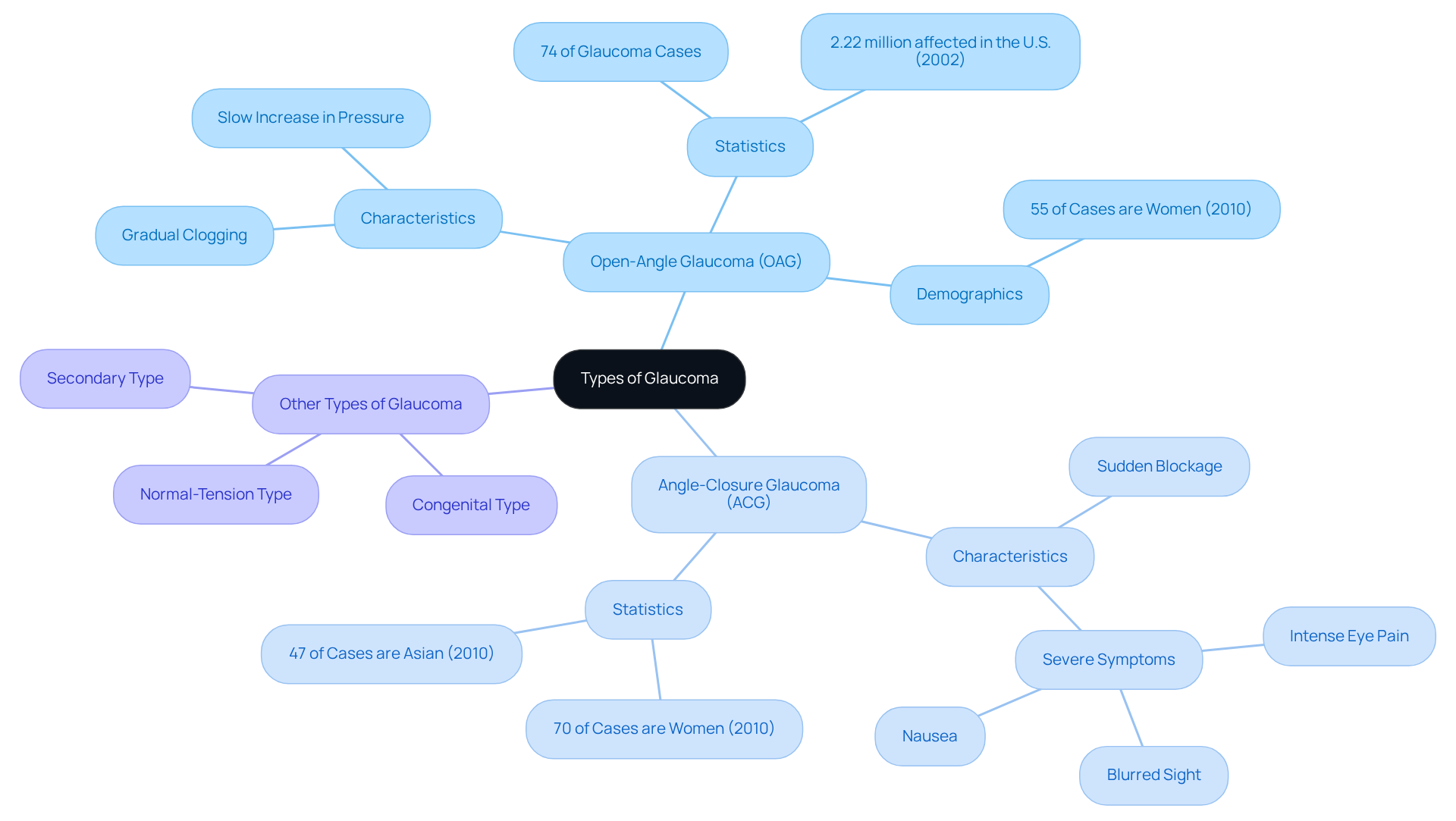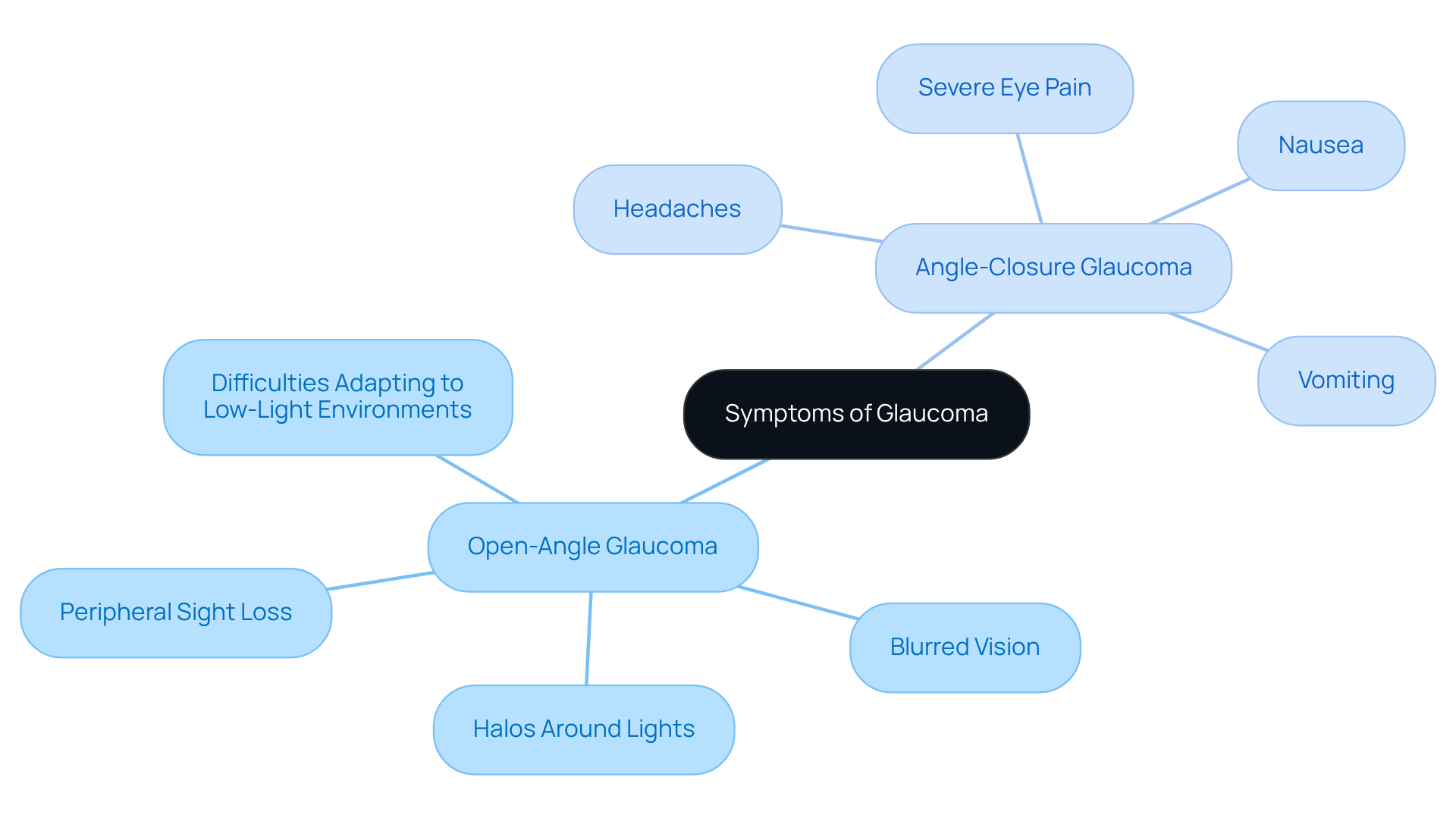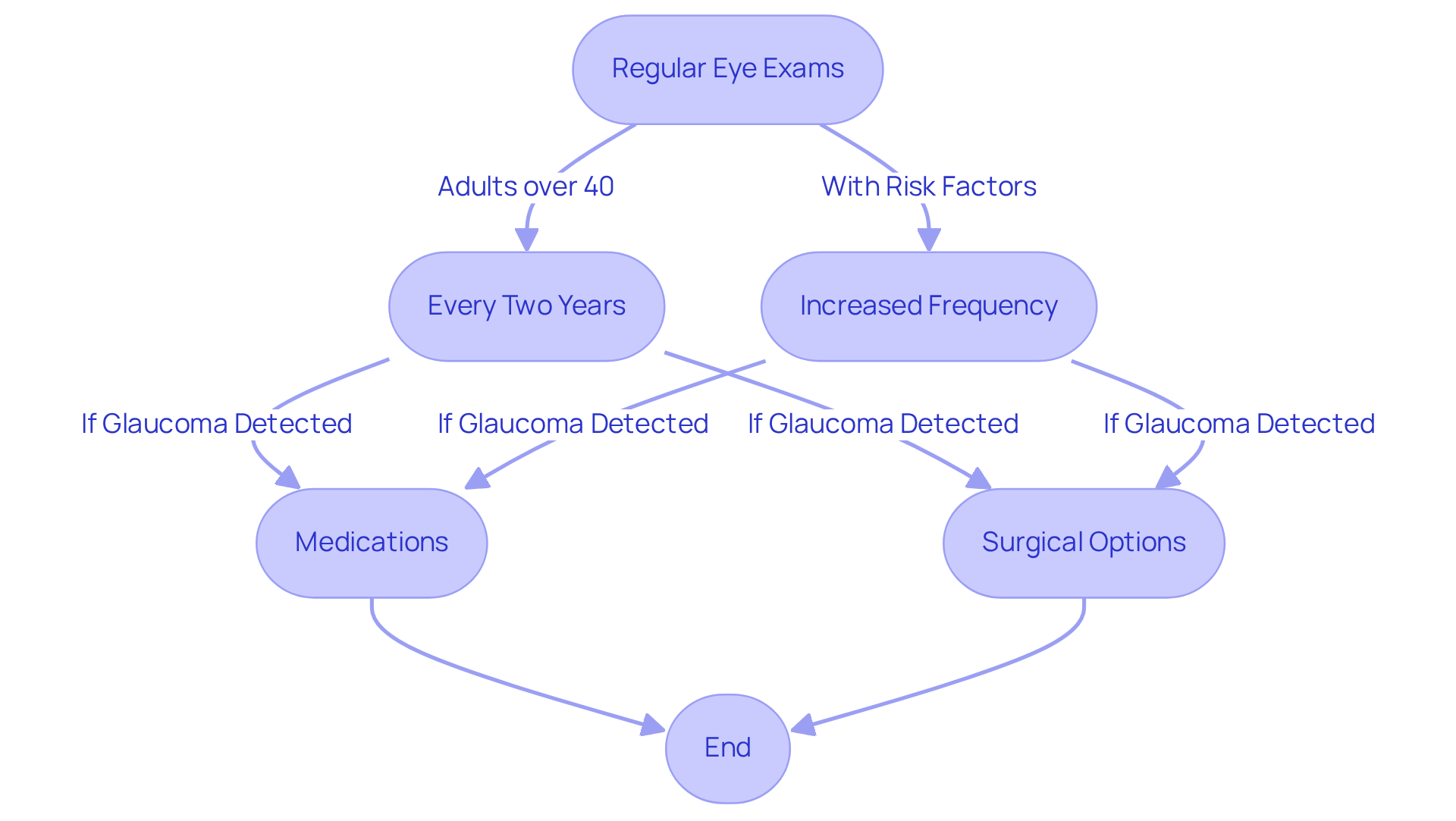Posted by: Northwest Eye in General on June 26, 2025
Overview
Recognizing the symptoms of glaucoma can be a crucial step in safeguarding your vision. Key signs to look out for include:
- Peripheral sight loss
- Blurred vision
- Halos around lights
- Severe eye pain (in the case of angle-closure glaucoma)
We understand that noticing these changes can be concerning.
Early detection through routine eye exams is vital. Many individuals may not realize they have glaucoma until significant damage has occurred. This is why we emphasize the importance of awareness and proactive eye care. It’s common to feel uncertain about your eye health, but taking action can lead to better outcomes.
Remember, you are not alone in this journey. We are here to help you through this process, ensuring you receive the care and support you need.
Introduction
Glaucoma, often referred to as the “silent thief of sight,” poses a significant threat to vision, affecting millions worldwide without overt symptoms until it’s too late. We understand that learning about this condition can be overwhelming, but as awareness grows, recognizing the early signs of glaucoma becomes crucial for preserving your eye health.
What challenges do individuals face in recognizing these symptoms, and how can timely intervention make a difference in their outcomes?
Exploring the key indicators of glaucoma not only empowers you to take charge of your eye health but also highlights the urgent need for regular eye examinations in combating this pervasive issue.
Remember, we are here to help you through this process.
Define Glaucoma: An Overview of the Condition
Glaucoma encompasses a group of eye diseases that can inflict damage on the optic nerve, primarily due to elevated intraocular pressure (IOP). This damage can lead to irreversible vision loss and, if left untreated, may culminate in blindness. We understand that this condition is often referred to as the ‘silent thief of sight,’ as it usually progresses without apparent signs, including symptoms of glaucoma, until significant harm has taken place. As of 2025, it is estimated that approximately 79.6 million individuals are impacted by glaucoma, with projections indicating this number could rise to 111.8 million by 2040. This situation stands as one of the foremost causes of irreversible blindness globally, underscoring the critical need for awareness and understanding.
At Northwest Eye, we believe that empowering patients through knowledge is essential for better eye health. Our Be Eye Wise initiative seeks to improve awareness of eye issues such as high eye pressure, ensuring that patients are educated about . It’s common to feel overwhelmed by medical information, but we are here to help you through this process. Ophthalmologists emphasize that early detection and treatment of the symptoms of glaucoma are vital, as timely intervention can significantly mitigate the risk of vision loss.
Recent studies highlight that at least half of those with glaucoma remain unaware of their condition, especially in developing areas where detection rates are shockingly low. Therefore, enhancing public awareness about eye pressure conditions is essential to prevent visual disability and improve patient outcomes. As noted by experts, “Due to the high inheritance rate of this eye condition, individuals with a family history of it should be educated about it and screened for it as early as possible.”
Additionally, socioeconomic factors play a crucial role, as individuals from lower-income backgrounds are less likely to receive necessary eye examinations, further complicating the challenge of managing this significant public health issue. At Northwest Eye, we encourage you to learn more about your eye health, explore our LASIK Self-Test, and schedule an appointment to discuss any concerns you may have.
Hear from our patients:
- “Great place. The doctors and staff were extremely patient with our very active 15-month-old daughter.” – Lydea L.
- “All of the staff at Northwest Eye are friendly and get your needs taken care of in the best of ways. A visit to any of the clinics is a great experience.” – Perry H.
Explore Types of Glaucoma: Open-Angle, Angle-Closure, and More
Glaucoma encompasses several types, with open-angle glaucoma (OAG) and angle-closure glaucoma (ACG) being the most prevalent. We understand that learning about these conditions can be overwhelming, but it’s important to know that:
- OAG is characterized by a gradual clogging of the eye’s drainage canals. This leads to a slow increase in intraocular pressure, often without noticeable symptoms until significant damage occurs.
- ACG presents a sudden blockage of these canals, causing a rapid spike in eye pressure accompanied by severe symptoms such as intense eye pain, nausea, and blurred sight.
There are also other types of eye pressure issues, including:
- Normal-tension type
- Congenital type
- Secondary type
These can arise due to other medical situations or treatments. Each type requires customized diagnostic and treatment approaches to effectively handle the issue and preserve vision.
Statistics suggest that by 2020, roughly 79.6 million people worldwide will be impacted by this eye condition, a notable rise from 60.5 million in 2010, with OAG representing approximately 74% of these instances. It’s common to feel concerned about these numbers, especially knowing that the prevalence of ACG is notably higher in certain demographics. For instance:
- Women comprise 70% of ACG cases
- Asian populations represent 47% of those diagnosed
Understanding these distinctions is crucial for effective management and treatment, as the approaches for OAG and ACG differ significantly. We want to emphasize the importance of in preserving your vision.
Moreover, the financial strain of the eye disease is projected to be $2.86 billion each year in the U.S., highlighting the necessity for awareness and proactive oversight of this issue. We are here to help you through this process, ensuring you have the support and information you need to navigate your journey with glaucoma.

Identify Symptoms of Glaucoma: Early Signs and Progression
The symptoms of glaucoma can vary significantly based on the type and stage of the disease. We understand that in the early phases of open-angle eye disease, many patients may feel reassured as they remain symptom-free. This is why routine eye check-ups are essential for early identification. Studies reveal that almost 50% of individuals with eye pressure issues are unaware of their health status, with notable differences among groups—16% of African Americans and 9% of Caucasians were unaware of this eye disorder.
As the condition progresses, it’s common to start noticing symptoms of glaucoma, including:
- Peripheral sight loss
- Blurred vision
- Halos around lights
- Difficulties adapting to low-light environments
On the other hand, angle-closure ocular hypertension can present suddenly with acute symptoms of glaucoma, which include:
- Severe eye pain
- Headaches
- Nausea
- Vomiting
Recognizing these signals quickly is crucial for initiating prompt care and preserving your sight.
Ophthalmologists emphasize that without proper care, glaucoma can lead to permanent vision loss. This makes early detection and action vital. Real-world cases illustrate that patients who prioritize regular eye exams are more likely to catch the disease in its early stages, significantly improving their chances of maintaining their vision and quality of life.
Additionally, the economic impact of glaucoma is substantial, costing the U.S. approximately $2.86 billion each year due to medical expenses and lost productivity. This underscores the importance of and awareness. We are here to help you through this process, ensuring you receive the support and care you need.

Emphasize Early Detection: Importance of Regular Eye Exams
Routine eye examinations are crucial for the early identification of this condition, often referred to as the ‘silent thief of sight.’ This nickname arises from the lack of symptoms of glaucoma until significant harm has occurred. We understand that this can be concerning, which is why the American Academy of Ophthalmology recommends that adults over 40 undergo comprehensive eye exams every two years. For those with risk factors—such as a family history of eye disease or elevated intraocular pressure—this frequency increases.
It’s common to feel anxious about medical tests, but prompt identification through these exams is essential. This allows for timely interventions, including medications or surgical options, to control eye pressure effectively and prevent permanent sight loss. Eye care professionals emphasize that recognizing the importance of regular eye exams is vital for maintaining overall health and quality of life.
Consider that proactive measures can significantly enhance the likelihood of detecting the symptoms of glaucoma early, which leads to better management and preservation of sight. With over each year for glaucoma-related concerns, the importance of routine eye care cannot be overstated. By prioritizing regular eye exams, you can take significant steps toward safeguarding your vision and overall eye health. We are here to help you through this process.

Conclusion
Understanding the symptoms of glaucoma is crucial for safeguarding your vision and preventing irreversible damage. We understand that recognizing early signs and seeking timely medical intervention can feel overwhelming. Glaucoma, often termed the “silent thief of sight,” can progress unnoticed until significant harm has occurred. This makes awareness and education vital in combating this condition.
We want to highlight the various types of glaucoma, such as open-angle and angle-closure, each presenting unique symptoms and requiring different management strategies. It’s alarming to know that nearly half of those with glaucoma are unaware of their condition. This underscores the necessity for regular eye exams and proactive monitoring, especially for individuals with risk factors. By prioritizing your eye health through routine check-ups, you can significantly enhance your chances of early detection and effective treatment.
In conclusion, the significance of understanding glaucoma and its symptoms cannot be overstated. We encourage you to take charge of your eye health by scheduling regular exams and educating yourself about the condition. Awareness and timely action are essential steps toward preserving your vision and improving your quality of life. Remember, proactive eye care is key to effectively combating glaucoma, and we are here to help you through this process.
Frequently Asked Questions
What is glaucoma?
Glaucoma is a group of eye diseases that can damage the optic nerve, primarily due to elevated intraocular pressure (IOP), potentially leading to irreversible vision loss and blindness if untreated.
Why is glaucoma referred to as the “silent thief of sight”?
Glaucoma is called the “silent thief of sight” because it often progresses without noticeable symptoms until significant damage has occurred.
How many people are affected by glaucoma?
As of 2025, approximately 79.6 million individuals are estimated to be impacted by glaucoma, with projections suggesting this number could rise to 111.8 million by 2040.
What is the importance of early detection and treatment of glaucoma?
Early detection and treatment are vital because timely intervention can significantly reduce the risk of vision loss associated with glaucoma.
What factors contribute to the awareness and detection of glaucoma?
Awareness and detection of glaucoma are affected by socioeconomic factors, with individuals from lower-income backgrounds being less likely to receive necessary eye examinations.
How can individuals with a family history of glaucoma manage their risk?
Individuals with a family history of glaucoma should be educated about the condition and screened for it as early as possible due to the high inheritance rate.
What initiatives does Northwest Eye undertake to promote eye health awareness?
Northwest Eye’s Be Eye Wise initiative aims to improve awareness of eye issues, including high eye pressure, and educate patients about their eye wellness and treatment options.
How can I learn more about my eye health and schedule an appointment?
You can learn more about your eye health by exploring resources like the LASIK Self-Test and scheduling an appointment to discuss any concerns with Northwest Eye.






